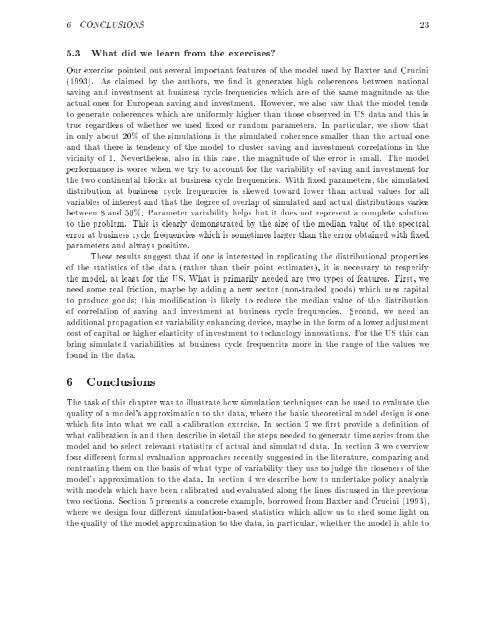Testing Calibrated General Equilibrium Models - Universitat ...
Testing Calibrated General Equilibrium Models - Universitat ...
Testing Calibrated General Equilibrium Models - Universitat ...
You also want an ePaper? Increase the reach of your titles
YUMPU automatically turns print PDFs into web optimized ePapers that Google loves.
6 CONCLUSIONS 23<br />
5.3 What did we learn from the exercises?<br />
Our exercise pointed out several important features of the model used by Baxter and Crucini<br />
(1993). As claimed by the authors, we nd it generates high coherences between national<br />
saving and investment at business cycle frequencies which are of the same magnitude as the<br />
actual ones for European saving and investment. However, we also saw that the model tends<br />
to generate coherences which are uniformly higher than those observed in US data and this is<br />
true regardless of whether we used xed or random parameters. In particular, we show that<br />
in only about 20% of the simulations is the simulated coherence smaller than the actual one<br />
and that there is tendency of the model to cluster saving and investment correlations in the<br />
vicinity of1. Nevertheless, also in this case, the magnitude of the error is small. The model<br />
performance is worse when we try to account forthevariability ofsaving and investment for<br />
the two continental blocks at business cycle frequencies. With xed parameters, the simulated<br />
distribution at business cycle frequencies is skewed toward lower than actual values for all<br />
variables of interest and that the degree of overlap of simulated and actual distributions varies<br />
between 8 and 50%. Parameter variability helps but it does not represent a complete solution<br />
to the problem. This is clearly demonstrated by the size of the median value of the spectral<br />
error at business cycle frequencies which is sometimes larger than the error obtained with xed<br />
parameters and always positive.<br />
These results suggest that if one is interested in replicating the distributional properties<br />
of the statistics of the data (rather than their point estimates), it is necessary to respecify<br />
the model, at least for the US. What is primarily needed are two types of features. First, we<br />
need some real friction, maybe by adding a new sector (non-traded goods) which uses capital<br />
to produce goods this modi cation is likely to reduce the median value of the distribution<br />
of correlation of saving and investment at business cycle frequencies. Second, we need an<br />
additional propagation or variability enhancing device, maybe in the form of a lower adjustment<br />
cost of capital or higher elasticity ofinvestment to technology innovations. For the US this can<br />
bring simulated variabilities at business cycle frequencies more in the range of the values we<br />
found in the data.<br />
6 Conclusions<br />
The task of this chapter was to illustrate how simulation techniques can be used to evaluate the<br />
quality of a model's approximation to the data, where the basic theoretical model design is one<br />
which tsinto what we call a calibration exercise. In section 2 we rst provide a de nition of<br />
what calibration is and then describe in detail the steps needed to generate time series from the<br />
model and to select relevant statistics of actual and simulated data. In section 3 we overview<br />
four di erent formal evaluation approaches recently suggested in the literature, comparing and<br />
contrasting them on the basis of what type of variability they use to judge the closeness of the<br />
model's approximation to the data. In section 4 we describe how to undertake policy analysis<br />
with models which have been calibrated and evaluated along the lines discussed in the previous<br />
two sections. Section 5 presents a concrete example, borrowed from Baxter and Crucini (1993),<br />
where we design four di erent simulation-based statistics which allow us to shed some light on<br />
the quality of the model approximation to the data, in particular, whether the model is able to
















